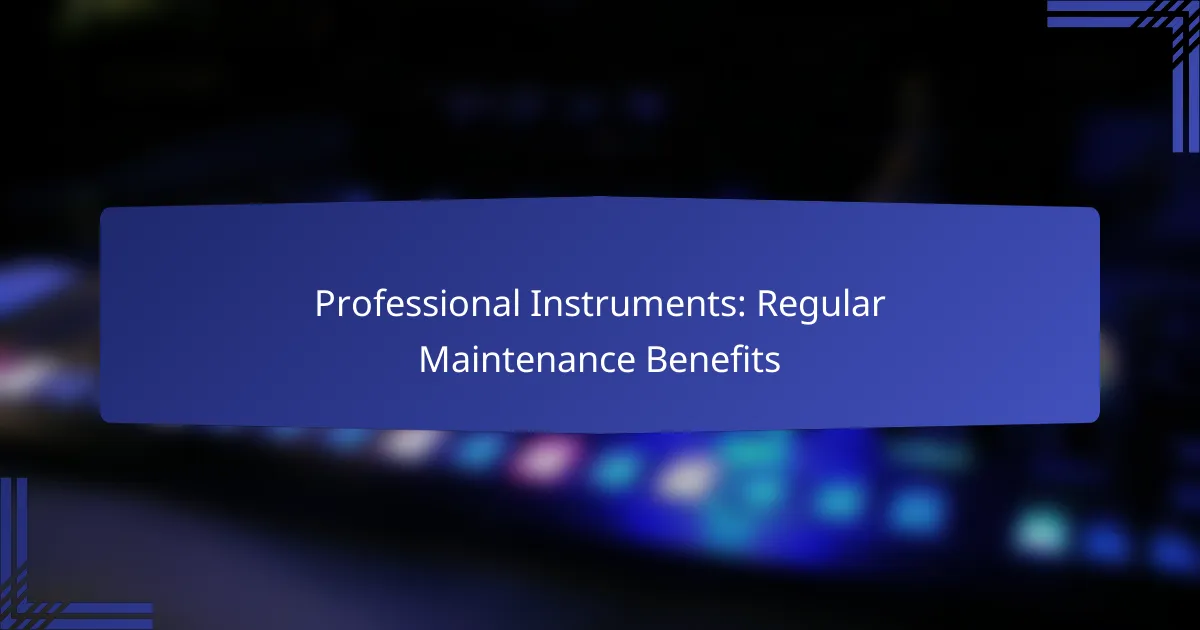Regular maintenance for professional instruments is crucial for maximizing their performance and lifespan. By implementing a consistent maintenance routine, users can prevent unexpected failures, ensure accuracy, and ultimately save on repair costs. Key practices such as cleaning, calibration, and inspections play a vital role in maintaining the reliability of these essential tools.
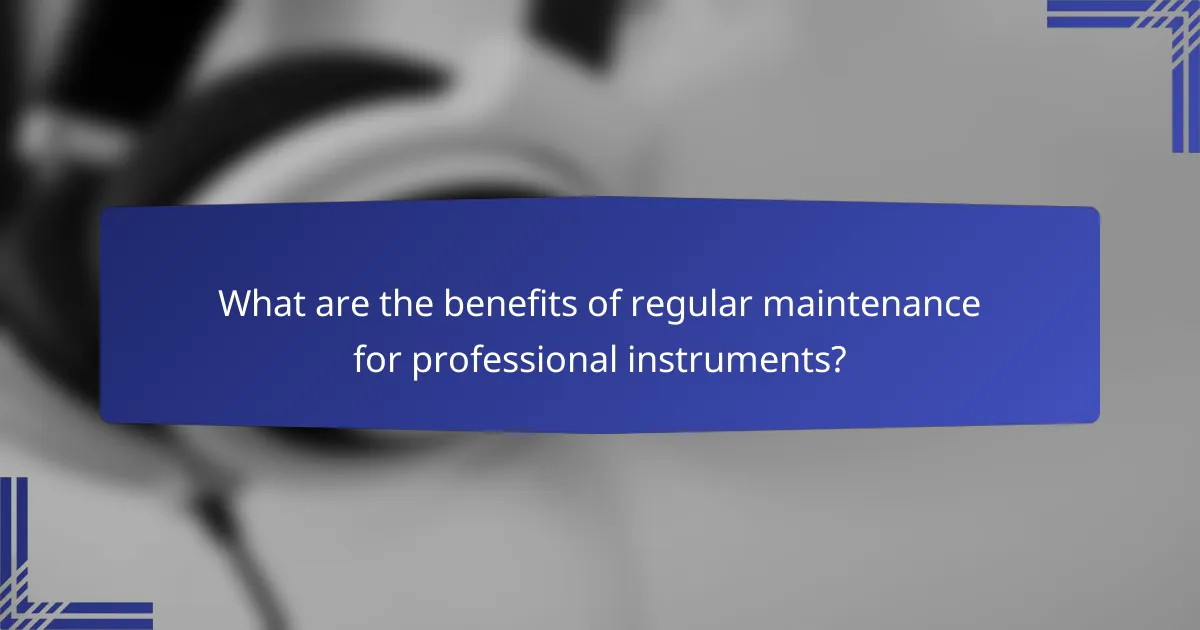
What are the benefits of regular maintenance for professional instruments?
Regular maintenance for professional instruments significantly enhances their functionality and longevity. By adhering to a consistent maintenance schedule, users can ensure optimal performance, reduce unexpected failures, and ultimately save on costs.
Improved performance
Regular maintenance directly contributes to improved performance of professional instruments. This involves routine checks and calibrations that keep the instruments operating at their best, ensuring they meet the required standards for accuracy and efficiency.
For example, a well-maintained audio mixing console will provide clearer sound quality and more reliable outputs compared to one that is neglected. Regular cleaning and adjustments can prevent minor issues from escalating into major problems.
Extended lifespan
Consistent maintenance can significantly extend the lifespan of professional instruments. By addressing wear and tear early, users can avoid the need for costly replacements and keep their equipment in service for longer periods.
Instruments such as cameras or musical equipment benefit from regular inspections and servicing, which can add years to their usability. For instance, cleaning the internal components of a camera can prevent damage from dust and moisture, thereby prolonging its life.
Enhanced accuracy
Regular maintenance ensures that professional instruments remain accurate and reliable. Calibration and adjustments are crucial to maintaining precision, especially in fields like engineering or medical diagnostics.
For instance, a calibrated measuring tool will provide consistent results, which is vital for quality control processes. Neglecting this aspect can lead to errors that may compromise projects or safety standards.
Reduced repair costs
Investing in regular maintenance can lead to reduced repair costs over time. By identifying and addressing issues early, users can prevent minor problems from developing into major repairs that are often more expensive.
For example, replacing worn-out parts during routine maintenance is typically cheaper than waiting for a complete failure. This proactive approach can save hundreds or even thousands of dollars in the long run.
Increased reliability
Increased reliability is a key benefit of regular maintenance for professional instruments. When instruments are well-maintained, they are less likely to fail unexpectedly, which is crucial in high-stakes environments.
For example, in a laboratory setting, reliable instruments are essential for accurate test results. Regular maintenance checks can ensure that all equipment functions properly, minimizing downtime and maintaining productivity.
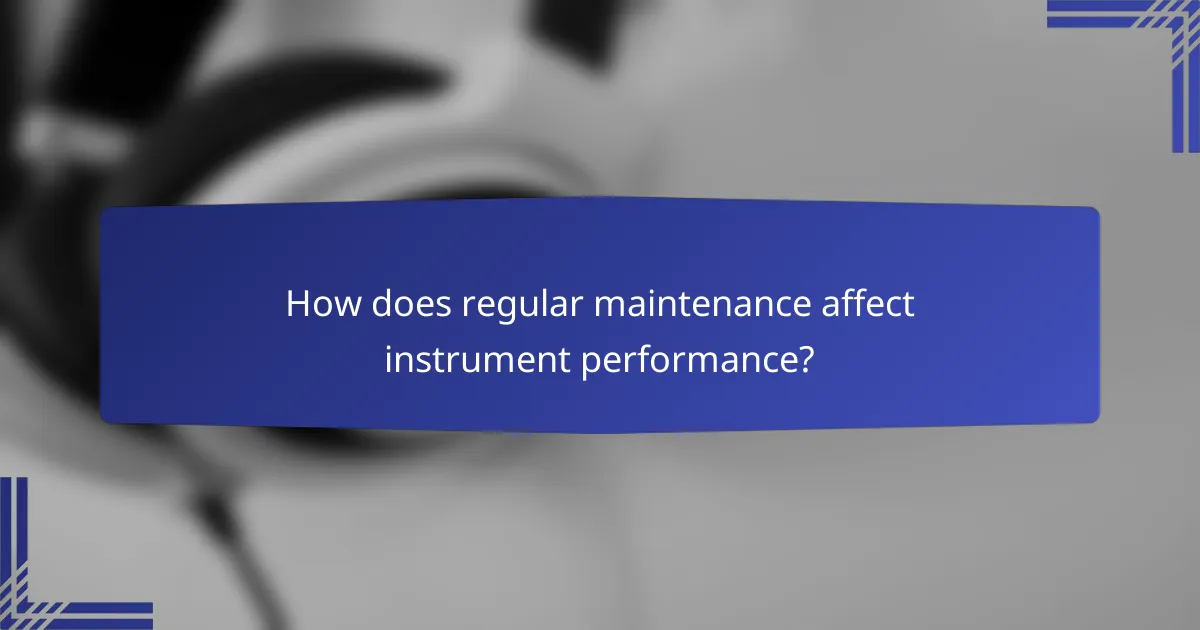
How does regular maintenance affect instrument performance?
Regular maintenance significantly enhances instrument performance by ensuring reliability and accuracy. By routinely checking and servicing instruments, users can prevent issues that may lead to inaccurate readings or equipment failure.
Prevents malfunctions
Regular maintenance helps identify potential problems before they escalate into serious malfunctions. For instance, routine inspections can reveal wear and tear on components, allowing for timely replacements and repairs.
Instruments that are well-maintained are less likely to experience unexpected breakdowns, which can disrupt operations and incur additional costs. Implementing a maintenance schedule can reduce downtime and improve overall efficiency.
Ensures optimal calibration
Maintaining instruments regularly ensures they remain properly calibrated, which is crucial for accurate measurements. Calibration drift can occur over time due to environmental factors or usage, leading to erroneous results.
By adhering to a calibration schedule, users can ensure that their instruments meet industry standards and provide reliable data. Regular checks and adjustments can help maintain precision, which is particularly important in fields such as laboratory testing and manufacturing.
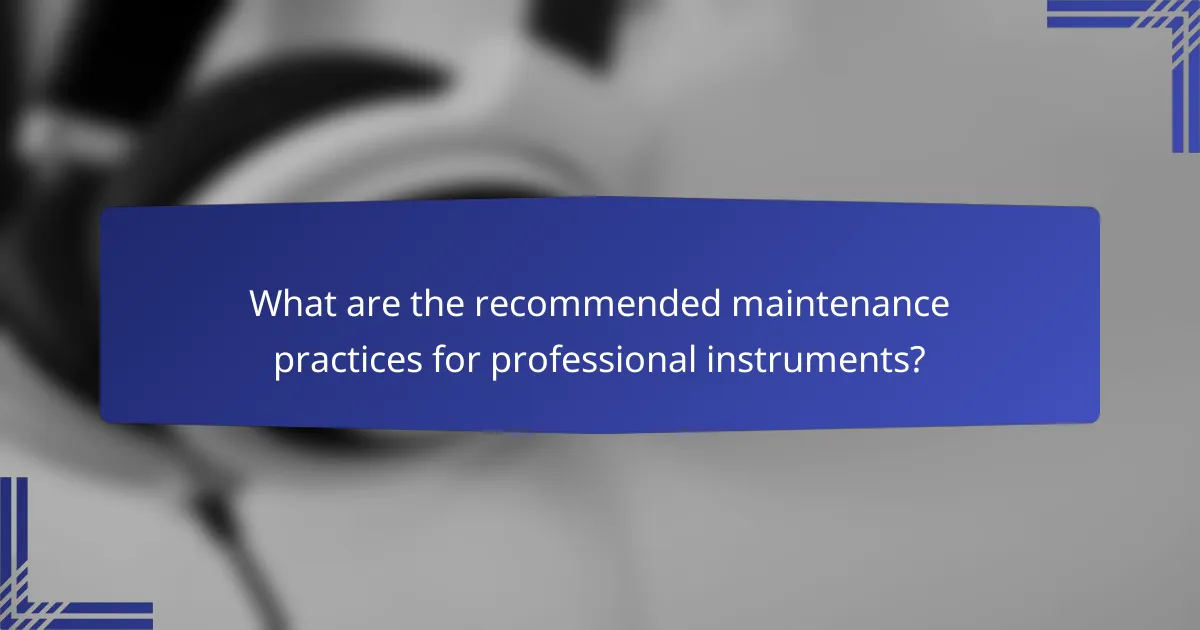
What are the recommended maintenance practices for professional instruments?
Recommended maintenance practices for professional instruments include routine cleaning, regular calibration, and component inspections. These practices help ensure accuracy, longevity, and optimal performance of the instruments.
Routine cleaning
Routine cleaning is essential for maintaining the functionality and accuracy of professional instruments. Regularly removing dust, debris, and contaminants prevents interference with measurements and prolongs the lifespan of the equipment.
Use appropriate cleaning solutions and tools specific to the instrument type. For example, optical instruments may require lens wipes, while electronic devices might need anti-static cloths. Establish a cleaning schedule based on usage frequency, aiming for at least weekly cleanings for high-use items.
Regular calibration
Regular calibration ensures that professional instruments provide accurate readings. Calibration should be performed according to the manufacturer’s recommendations, typically every few months or after significant use or environmental changes.
Consider using certified calibration services to maintain compliance with industry standards. Keeping a calibration log can help track when calibrations were last performed and when the next ones are due, ensuring consistency in performance.
Component inspections
Component inspections involve checking the physical and functional aspects of the instrument to identify wear or damage. Regular inspections can help catch issues early, preventing costly repairs or replacements.
Inspect critical components such as sensors, connectors, and mechanical parts for signs of wear. Establish a checklist for inspections, including visual checks and functional tests. Aim for inspections at least quarterly, or more frequently for instruments subjected to harsh conditions.

How often should professional instruments be maintained?
Professional instruments should typically be maintained on a regular schedule to ensure optimal performance and longevity. Maintenance frequency can vary based on the type of instrument, usage intensity, and manufacturer recommendations.
Monthly checks
Monthly checks are essential for identifying minor issues before they escalate. This includes inspecting for visible wear, cleaning components, and ensuring calibration is within acceptable limits.
During these checks, focus on key areas such as connections, sensors, and any moving parts. A simple checklist can help streamline the process, ensuring nothing is overlooked.
Quarterly servicing
Quarterly servicing involves a more thorough examination and maintenance of professional instruments. This may include replacing worn parts, recalibrating, and performing detailed cleaning.
Consider scheduling these services during quieter periods to minimize disruption. Keeping a log of all maintenance activities can help track instrument performance and identify trends over time.
Annual overhauls
Annual overhauls are comprehensive maintenance procedures that typically involve disassembling the instrument for a complete inspection. This is the time to address any significant repairs and perform upgrades if necessary.
These overhauls can help extend the lifespan of the instrument and ensure compliance with industry standards. Budgeting for these annual services is crucial, as they may involve higher costs due to labor and replacement parts.
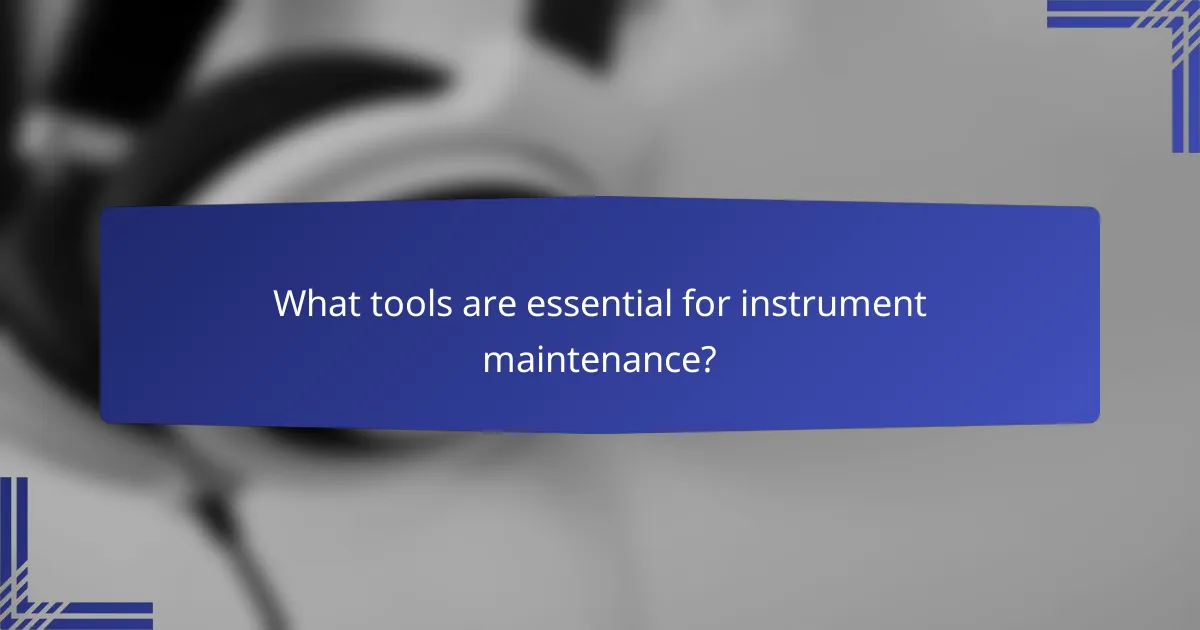
What tools are essential for instrument maintenance?
Essential tools for instrument maintenance include calibration tools, cleaning kits, and diagnostic software. These tools help ensure that instruments operate accurately and efficiently, prolonging their lifespan and maintaining performance standards.
Calibration tools
Calibration tools are critical for verifying and adjusting the accuracy of instruments. They often include reference standards, gauges, and calibration weights that help ensure measurements are precise. Regular calibration can prevent costly errors and maintain compliance with industry standards.
When selecting calibration tools, consider the specific instruments you are working with and the required accuracy levels. It’s advisable to calibrate instruments at least annually or more frequently based on usage intensity.
Cleaning kits
Cleaning kits are essential for maintaining the physical condition of instruments, preventing contamination and wear. A typical cleaning kit may include brushes, wipes, solvents, and protective covers tailored to the specific instrument type.
Regular cleaning should be part of your maintenance schedule, especially for instruments exposed to dust or corrosive environments. Follow manufacturer guidelines for cleaning procedures to avoid damaging sensitive components.
Diagnostic software
Diagnostic software is used to monitor instrument performance and identify potential issues before they escalate. This software can provide real-time data analysis, performance tracking, and alerts for maintenance needs.
Investing in reliable diagnostic software can save time and resources by streamlining maintenance processes. Ensure that the software is compatible with your instruments and that you regularly update it to benefit from the latest features and improvements.

What are the costs associated with instrument maintenance?
The costs of instrument maintenance can vary widely based on the type of instrument, frequency of use, and specific maintenance requirements. Regular maintenance often includes expenses for parts, labor, and potential downtime, which can add up over time.
Direct costs of maintenance
Direct costs include the price of replacement parts, service fees, and any specialized tools required for maintenance. For instance, a simple calibration might cost anywhere from $50 to $200, while more complex repairs could reach several hundred dollars. It’s essential to budget for these expenses to avoid unexpected financial burdens.
Indirect costs of neglect
Neglecting regular maintenance can lead to indirect costs such as decreased efficiency, increased energy consumption, and potential loss of revenue due to instrument downtime. For example, an uncalibrated instrument might produce inaccurate results, leading to costly errors in production or service delivery.
Long-term savings
Investing in regular maintenance can lead to long-term savings by extending the lifespan of instruments and reducing the frequency of major repairs. A well-maintained instrument can operate efficiently for years, potentially saving thousands of dollars compared to the costs associated with frequent breakdowns and replacements.
